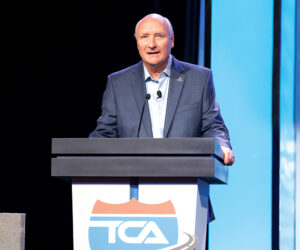When we reported the top 10 industry concerns as rated though a survey of professional truck drivers, motor carrier executives and other industry stakeholders, the lack of truck parking was rated No. 2 among driver and No. 9 among motor carrier executives.
Overall, it ranked No. 5.
Based on the survey, the American Transportation Research Institute (ATRI) listed the top three strategies that would help ease the situation, realizing that it would never be totally solved.
In our coverage, we listed the strategies for the top three overall issues – the driver shortage, Hours of Service and driver retention – but stopped there.
Today, we want to list the strategies for alleviating the truck parking problem.
In its report, ATRI noted that the growing scarcity of available truck parking has created a dangerous and costly dilemma for truck drivers, who are often forced to drive beyond allowable HOS rules or park in undesignated and, in many cases unsafe, locations. The Federal Highway Administration last year updated the original 2015 Jason’s Law Truck Parking Survey Results and Comparative Analysis, which confirmed that the lack of safe truck parking continues to be a major issue in the United States.
The FHWA work is being done through the National Coalition of Truck Parking and its four work groups: Parking Capacity; Technology and Data; Funding, Finance and Regulations; and State, Regional, and Local Government Coordination.
Nothing necessarily concrete was included in the update, based on published reports.
Here are the top three strategies for the truck parking issue, as listed in the ATRI survey:
- Identify strategic locations on the National Freight Network for new or expanded truck parking due to increased traffic congestion and industry/regulatory changes. A majority of survey respondents (50.2 percent) have indicated that identifying strategic locations to expand truck parking capacity is their preferred strategy for addressing the pervasive shortage of truck parking. In particular, reopening shuttered parking facilities and investing in new facilities are the most direct strategies aimed at alleviating the chronic and growing shortage of truck parking along the National Freight Network. Other options, such as repurposing vacant urban and suburban land parcels for truck parking, are also being explored as potential solutions to this critical industry issue.
- Educate the public sector on the safety consequences that result from closing public parking facilities and/or failing to expand truck parking availability. The Jason’s Law Report first brought attention to the safety risks commercial drivers face because of the truck parking shortage, and more recent research continues to quantify the safety impacts of an inadequate supply of truck parking. ATRI’s truck parking diary research quantified the frequency in which drivers are forced to park in undesignated or unauthorized truck parking locations like highway shoulders or ramps, with 48.7 percent of drivers reporting that the parking shortage leads them to do so between three to seven times per week. As such, this is the preferred strategy for 38.2 percent of respondents, up from 29 percent in 2017, as a growing number of industry stakeholders hope that educating state and local officials on the critical need for safe truck parking facilities could lead to new investments.
- Research the role and value of real-time truck parking information availability and truck parking reservation systems. Leveraging technological advancements to develop real-time truck parking solutions was the preferred strategy for a small but growing percentage of respondents. The share of respondents selecting this strategy increased from 7.2 percent to 11.7 percent reflecting the considerable public-sector interest and investment in these systems.
We all know that the federal government moves slowly, so we thought we’d bring you a few nuggets from the minutes of the August meeting of the Parking Capacity work group that show the inertia of such meetings. One working-group member pointed out that there was a typo in the description of the Louisiana example; Another working-group member stated that the working group should consider rephrasing the description of vault toilets to say that they cost less than port-o-johns, and that the current description fails to demonstrate that vault toilets increase capacity for truck parking; and finally a discussion about presentation packing: the working group responded that they like having the documents separate and not compiled into a single large document. Another group member said that they like them separate, but organized by working group, while a third shared that they’d prefer to have the documents compiled into a single large document.
Meanwhile, truckers struggle to find safe parking places.
Lyndon Finney’s publishing career spans over 55 years beginning with a reporter position with the Southwest Times Record in Fort Smith, Arkansas, in 1965. Since then he’s been a newspaper editor at the Southwest Times Record, served five years as assistant managing editor of the Arkansas Democrat-Gazette in Little Rock and from November 2004 through December 2019 served as editor of The Trucker. Between newspaper jobs he spent 14 years as director of communications at Baptist Health, Arkansas’ largest healthcare system. In addition to his publishing career he served for 46 years as organist at Little Rock’s largest Baptist church.








